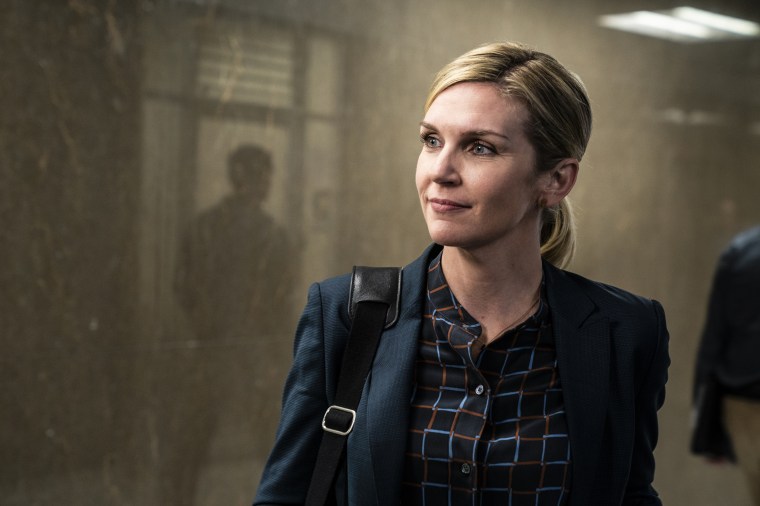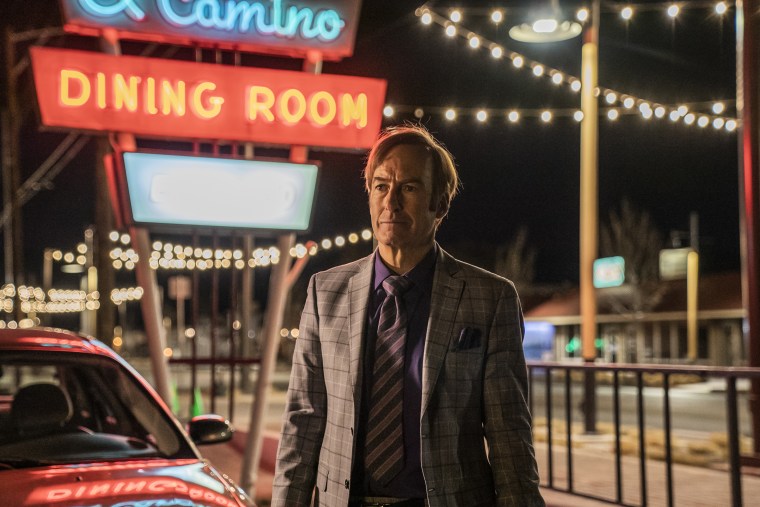Bob Odenkirk chose his words carefully.
The actor and comedian, perched on a couch at his home in Los Angeles, attempted to answer questions about the final season of "Better Call Saul," his “Breaking Bad” spinoff series, without uttering a word that might be construed as a spoiler.
“I now know what happens, of course,” Odenkirk said matter of factly, “and I would love to talk about it with you.”
It might seem strange that the final 13 episodes of “Better Call Saul” are dotted with so many question marks ahead of the season premiere on April 18 on AMC. The show is a prequel to one of the most popular series of the last quarter-century, which means millions of people around the world already know that Odenkirk’s character, the low-rent Albuquerque huckster and hapless public defender Jimmy McGill, transforms into the flashy, flamboyant drug lawyer known as Saul Goodman on “Breaking Bad.”
But the writers of “Better Call Saul” have always had more tricks up their pinstripe sleeves.
In the course of 50 intricately written episodes, co-creators Vince Gilligan and Peter Gould have hooked viewers on a gallery of characters who do not even appear on “Breaking Bad” — as far as we know. What fate will befall the besieged cartel lieutenant Nacho Vargo (Michael Mando); Jimmy’s ethically malleable partner, Kim Wexler (Rhea Seehorn); the white-shoe attorney Howard Hamlin (Patrick Fabian)? How exactly do their rich storylines intersect with the saga of Walter White (Bryan Cranston), the meth-cooking antihero who started it all?
“I think the ways in which ‘Breaking Bad’ and ‘Better Call Saul’ are tied together in our final season will be a great satisfaction for all the fans,” Odenkirk said in a Zoom conversation, seeming to consider every syllable as he spoke.
Gould, for his part, recently confirmed that the final season will feature guest appearances from Cranston and Aaron Paul, the Emmy-winning actor who played Walter's accomplice, Jesse Pinkman.
“Better Call Saul,” like its smash-hit predecessor, takes place in a decidedly shabby milieu: life on the margins of early 2000s Albuquerque, a parched landscape of run-down strip malls, stucco motels and cheap office trailers in the middle of the desert. Jimmy McGill starts off living in a utility closet in the back of a nail salon, where he tries (and fails) to break good as an above-board lawyer but finds more lucrative opportunities as a scam artist and fixer for some of the city’s most wretched criminals.
The series debuted in 2015, and the fifth season started airing on AMC more than two years ago, in late February 2020, just before Covid shut everything down and delayed production on the final installment. The production was briefly upended again after Odenkirk had a heart attack and collapsed on set in July 2021. He returned to filming in early September and told NBC News that he has recovered. Twenty-four months after the most recent episode aired, “Saul” feels like a welcome blast from the past in more ways than one.
The show was arguably prescient, too, anticipating a wave of stories about audacious grifters that encompasses documentaries about the ill-fated Fyre Festival to scripted projects about the Theranos founder Elizabeth Holmes (“The Dropout”) and the faux-socialite fraudster Anna Delvey (“Inventing Anna”). “Saul” is almost certainly the most incisive grifter tale of the lot: a darkly comic yet deeply sad portrait of a man essentially addicted to lying, utterly convinced that shameless corner-cutting will win him the respect he believes he deserves.
“Jimmy McGill is driven by his resentment and a sense of retribution. He’s led too often by feelings of hurt, instead of letting things go and making choices disconnected from those feelings,” Odenkirk said. “I would judge that to be a poor choice, but it’s the character that they [Gilligan and Gould] created, and they have to follow through on it.”
The soul of 'Saul'
“Breaking Bad” is one of the landmark shows of the prestige TV era, but the artistic fruitfulness of “Saul” was not assured. The prequel series lacks the original’s “Mr. Chips-to-Scarface” conceit and struts at a different tempo, low-key but jazzy. “Breaking Bad” was often high-octane; “Saul” is relatively more leisurely, with a defiantly shaggy dog spirit. And yet there are plenty of violent shocks and propulsive twists as Jimmy gets more deeply tied up with a vicious Juárez drug cartel and the gleefully sociopathic Lalo Salamanca (a terrifying Tony Dalton).
“Saul” is not a Nielsen-ratings behemoth like “Breaking Bad.” But many fans and critics now believe the two shows are equals, contrasting each other in provocative ways. Walter White’s descent into evil was Wagnerian in intensity, but the incremental nature of Jimmy’s moral downfall feels more painful, like witnessing a luckless friend slowly implode.
Seehorn, one of the show’s breakout performers, delighted in the chance to illustrate Kim Wexler’s stunning evolution, too, embodying a character who dwells in the gray zone between professional competence and ethical slipperiness.
“I find her fascinating, personally. They [the writers] allowed the room for there to be subtext. They do this with all the characters, but she [Kim] was constantly in situations where she didn’t show her cards,” Seehorn said. The result could have been inscrutable, she added, “but instead I was encouraged to play the subtext in a way that allowed the audience in.”
The prequel series also plumbs deeper into the psyches of some of the most rivetingly pulpy “Breaking Bad” characters, like the calmly calculating drug lord Gustavo “Gus” Fring (Giancarlo Esposito, unnerving) and gravelly ex-cop Mike Ehrmantraut (Jonathan Banks, never better). In an interview, Esposito said he was originally reluctant to reprise his role on “Saul,” uncertain that he could bring new dimensions to a villain known for his stone-faced countenance.
“I was suspicious,” Esposito said with a laugh, “and I had to talk to Vince about what the plan was. We had to come to an agreement that the mysterious nature of Gustavo, in terms of his background, should be preserved.” The prequel gave Esposito intriguing new notes to strike, too: “Gus [on 'Saul'] is more hot-headed, less reserved. His cards are less close to his chest.”
Esposito’s character met a particularly gruesome end on “Breaking Bad” — Google it, if you must, but you’ve been warned — and some “Saul” fans are fretting about what violent comeuppance or tragedy awaits their favorite characters. Mando — who plays Nacho, the beleaguered cartel subordinate desperate to break free of his brutal existence — said his character is pushed to the brink in season six, “with the highest stakes possible.”
“I never thought this would be a dream role for me, and it only really started making sense at the end of this season. When you’re in it for five or six years, you can’t really see outside of what you’re doing, you’re too close to the canvas,” Mando said. “The biggest surprise was how heroic, tragic and romantic the character was. I did not want to play a stereotypical cartel guy, and I wanted to give humanity to that part of the world.”
The end of the road
The final season, which airs in two parts — seven episodes in April and May, six episodes in July and August — draws a curtain on a character Odenkirk has played for much of the last 13 years, redefining the career of a journeyman performer previously best known for the cult HBO sketch series “Mr. Show.” It also closes a chapter on a surrogate family that sprung up around the production.
“It was a true family,” Seehorn said. “We read all the time about actors on shows who say they all get along, and I hope most casts do get along … but we are real friends.”
During the production of the last three seasons, Odenkirk shared a house in New Mexico with Seehorn and Fabian, a witty conversationalist who said he modeled his character’s distinctive walk on Cary Grant.

“We were like a college acting troupe,” Fabian said with a grin. “We’d spend all day with one another, and then we’d end up at home around the kitchen table talking about what happened today and what will happen tomorrow,” adding that the housemates rehearsed and ran lines together in between grocery store runs and hikes.
“Patrick was the activities director,” Odenkirk said affectionately. “Rhea and I were the indulgent actors — talking, talking, talking about their [expletive] characters,” Odenkirk joked. “We talked about motivations and theory and psychology and shooting styles, breaking it down all day long. It was a great friendship and partnership.”
The final season might offer closure on what became of Jimmy after he fled Albuquerque following the events of “Breaking Bad” and reinvented himself yet again as Gene Takovic, a manager at a shopping mall Cinnabon in Omaha, Nebraska. Odenkirk said he always believed it was important that the writers do not completely foreclose the possibility of enlightenment — or something like it — for his small-screen alter ego.
“I requested that they consider that occasionally people learn the right lessons. Walter White had a degree of self-awareness that he gained from his egotistical, selfish and destructive path. You could call that a benefit,” Odenkirk said. “I always wondered whether Vince Gilligan even believes it’s possible that a human being can learn the right lessons or grow in a positive way, instead of just becoming more consumed by their weaker instincts as they get older.”
Odenkirk’s request was to be “part of the conversation” behind the scenes, he said. But of course, the actor was tight-lipped about the endpoint of Jimmy McGill’s treacherous moral odyssey.
“I can’t tell you where it goes. It’s not black-and-white. I would not claim the character becomes a saint,” Odenkirk said, “because that’s not the case at all.”

